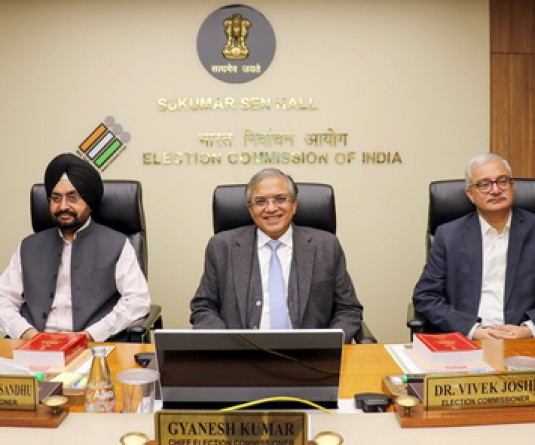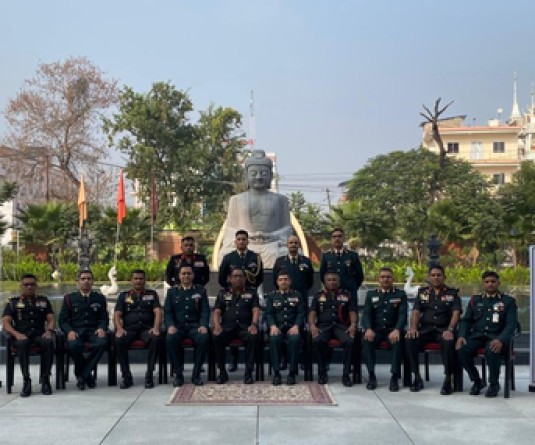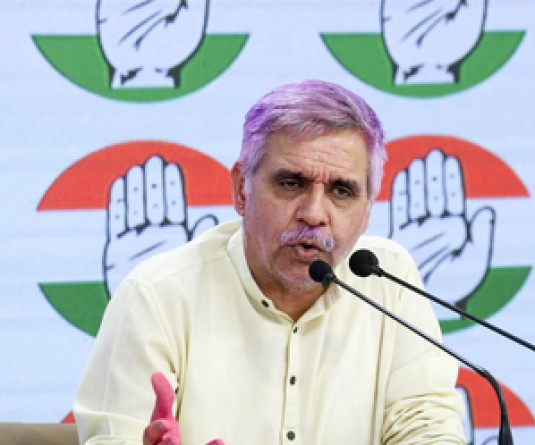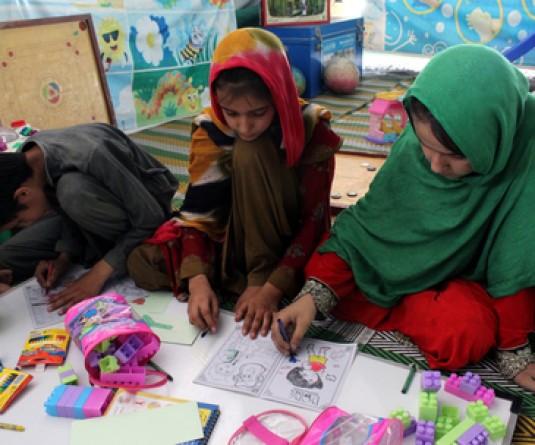Dr. Kumar Gaurav, 42, a medical professor and consultant psychiatrist who has been named the top official at Jawahar Lal Nehru Medical College and Hospital during the coronavirus disease (COVID-19) outbreak, puts on his personal protective equipment (PPE) as his wife Dr. Mili Jaswal, a psychologist, looks on, at their home in Bhagalpur, Bihar on July 27, 2020. Now, with some doctors struck down by the coronavirus and others refusing to work, Gaurav has been named the top official at the hospital, despite being one of its most junior consultants – and suffering from diabetes and hypertension, two risk factors for severe COVID-19. But Gaurav says he felt compelled to volunteer for the job. "A lot of my colleagues refused," he says. "I had to take up the responsibility." (REUTERS File Photo)
BHAGALPUR, August 13(Reuters): Guards armed with rifles escort Dr. Kumar Gaurav as he makes the rounds at his hospital on the banks of the Ganges River.
The guards are there to protect him from the relatives of patients, including those suffering from COVID-19. The relatives keep barging into the wards, even the ICU, to stroke and feed their loved ones, often without wearing even the flimsiest of masks as barriers against the novel coronavirus.
"If we stop them, they get angry," he says. "They want to give homemade meals to their patients, and some even want to massage their patients. And they are taking the infections from our ICUs to the other people in the society."
He stops to tell the wife of a patient in the ICU she must leave. She obeys, only to return after a few minutes from another entrance.
It's the monsoon season, and the humidity is reaching unbearable levels. But the few air conditioners in the hospital aren't working, and some relatives use hand fans to keep their loved ones cool in wards dirty with garbage and discarded protective equipment.
It wasn't supposed to be like this for Kumar.
Nine years ago, the 42-year-old psychiatrist moved his family back to his hometown for a quieter life and better pay after three years in the Indian capital, New Delhi. He accepted a job as a medical professor and consultant psychiatrist at the 900-bed Jawahar Lal Nehru Medical College and Hospital, named after India's first prime minister. Life was uneventful but rewarding, spent teaching classes and visiting his psychiatry patients.
Now, with some doctors struck down by the coronavirus and others refusing to work, he has been named the top official at the hospital, despite being one of its most junior consultants – and suffering from diabetes and hypertension, two risk factors for severe COVID-19.
But he says he felt compelled to volunteer for the job.
"A lot of my colleagues refused," he says. "I had to take up the responsibility."
In April, as the pandemic struck here in the eastern state of Bihar, the hospital was selected as one of just four COVID-dedicated hospitals for a population of 100 million people – at least in theory.
In practice, Kumar says the nearest hospital with proper critical-care facilities is around 200 kilometers (120 miles) away. And with proper healthcare in the surrounding rural areas difficult to find, general patients have nowhere else to go but his hospital.
In June, Kumar says, the district administration instructed the hospital to treat uninfected patients, too.
"In an ideal world, there should not be any non-COVID patients in this hospital," Kumar says.
The healthcare system in Bhagalpur, like many other parts of Bihar, is on the verge of collapse, he says.
Interviews with dozens of staff, patients and relatives at the hospital paint a picture of conditions that might shock those accustomed to images of hermetically sealed ICUs during the pandemic, with relatives not even allowed to touch their dying loved ones.
They tell of a chronic shortage of manpower and resources such as blood and medicines. All 37 beds in the ICU are occupied; on the floor next to one of the beds, a relative sits on a brightly colored blanket he has brought from home, a water bottle by his side.
Kumar says he feels powerless to prevent the lapses in isolation of the COVID patients.
"We don't know who is positive and who is negative," the psychiatrist says. "We don't know their status and we cannot wait for them to be tested. They just need the treatment. We are the most vulnerable population."
Spokesmen for India's federal government and the Bihar government, as well as several bureaucrats and ministers responsible for healthcare at federal and state level, didn't respond to detailed requests for comment. Pranav Kumar, the top bureaucrat in Bhagalpur district, also didn't respond to a request for comment.
TROUBLED STATE
As infections slow in many other countries, India is still reporting more than 50,000 cases per day. Its total of more than 2 million cases trails only the United States and Brazil, and cases show no signs of slowing. Since the pandemic struck India, more than 46,000 people have died.
Although India's major cities, such as New Delhi and Mumbai – the first to be hit by the virus – have registered a decline in cases, numbers in second-tier cities and rural areas continue to rise.
Bihar is India's third-most-populous state; if it were a country, it would be the 14th-most-populous in the world.
The state has a rich history, including the site where the Buddha is said to have attained enlightenment beneath the shade of a Bodhi tree.
But today, Bihar has a reputation as one of India's problem-plagued states.
Based on indicators including infant nutrition, Bihar's level of development has more in common with sub-Saharan Africa than India's prosperous southern states. Almost half of children under 5 in the state are stunted from malnutrition, with more than four in 10 underweight for their age, according to federal data.
Bihar also has the highest population growth in India, and one of the worst education systems, scoring poorly on indicators including adult literacy, the percentage of children attending school and exam results.
The healthcare system was overburdened even before the pandemic struck. Dr. Sunil Kumar, the Bihar secretary of the Indian Medical Association – the main healthcare union in India – said more than half the doctors' posts in the state are unfilled. That's because many doctors don't want to serve in rural areas, according to Bihar's top court, which urged the state government to do more to fill the roles in a ruling in May.
There have been around 87,000 confirmed cases of coronavirus in the state and 465 deaths – relatively small compared to other states. Given the low testing levels in the state, the numbers may be conservative. Still, Bihar's healthcare system is already close to breaking point, unlike places such as New Delhi, which has had many more cases but enjoys better resources.
The state government's response to the outbreak has prompted public interest litigation asking that India's federal government, led by Prime Minister Narendra Modi, take over management of the pandemic here.
One case, filed by local businessman Aditya Jalan, says "incalculable" lives will be lost if action isn't taken soon, especially with the pandemic spreading into less developed and more rural areas.
His petition cites a "complete breakdown of the public health infrastructure in the state of Bihar, including the lack of COVID-19 hospitals, the lack of hospital beds, the insufficient testing, the unsanitary quarantine centres, the lack of enforcement of social distancing measures, the insufficient medical personnel, [and] the failure to provide PPE to front-line workers."
India's Supreme Court is due to hear the case Friday.
The state's healthcare problems are particularly stark in rural Bihar, where government infrastructure is even more rudimentary. In Ismailpur, a village an hour's drive from Bhagalpur, the ongoing annual floods have cut off the main road to the highway. The floodwaters have reached the doorstep of the dilapidated primary health centre there, which caters to more than 52,000 people.
There are no beds or oxygen cylinders, and a dog and her litter rest on the discarded PPE kits in the corner of the coronavirus testing hall.
"It's a very backward area," says one of the two doctors in the center, Dr. Rakesh Ranjan. "People are scared to even get tested. We have to sometimes take police to get people tested."
HOSPITAL CHAOS
Psychiatrist Kumar's hospital backs onto the Ganges River, the holiest in India and swollen by the summer monsoon. Next to water buffalos bathing on the banks, private ambulance operators wash their vehicles with clanking buckets.
On the approach road to the hospital, there is a huge pothole, and vehicles carrying patients often get stuck there. Outside the main doors, relatives sit with the bodies of their loved ones waiting for private ambulances to take them for burial or cremation.
The workers who push the trolleys carrying incoming patients to the general emergency wards don't know the history of the new arrivals, most of whom haven't been tested yet for the virus. Often wearing only gloves as protective gear, the workers wheel them inside, take their oxygen levels and leave them on trolleys in the corridor, where some people are treated until they can find a bed.
In the corridor, an exhausted woman rests her head on a wall as her husband's blood sample is collected while he lies on a stretcher next to her. Inside one of the emergency wards, a woman drags her husband from a stretcher to his bed as their relative holds an IV bottle.
Kumar tries to be visible, touring the wards to motivate patients and staff. But it's a game of constant mental arithmetic. Patients expect to be seen by a senior doctor, but it isn't always possible.
"If I stand in front of a COVID patient for two minutes, and I see 20 patients, I have exposure for 40 minutes," he says.
With so few doctors, that kind of exposure is a risk he can't often afford to take.
Complaints from junior doctors are constant. During one meeting about a lack of medicines, Kumar promises them he will convince the government that more resources are needed. He later admits it will be difficult.
Kumar weeps as he describes his worst moment since he took over, when a friend of his father who needs blood transfusions at regular intervals asked for help.
"I had to say no, as we don't have enough blood in the bank. We just have just a minimum for emergencies," he says. He finds such refusals painful. "I don't know how to say no to a patient."
COMING HOME
Born in Bhagalpur, Kumar moved to the northern city of Chandigarh for his medical training, where he met his wife, Mili Jaswal, a psychologist.
After marrying, the young couple moved to New Delhi, where they adopted a street dog, Faith.
Kumar worked in a private hospital but couldn't handle the culture.
"Their orientation is how much financially you can give back to them," he says. "It's difficult for a doctor to work [like] this."
And so in 2011, Kumar, Mili and Faith boarded a train back to Bihar.
"Financial security was a big factor, and I had my family here," Kumar says.
His 6-year-old daughter, Iti Swara, was born a few years later. He dotes on her.
He recently had his two-bedroom government bungalow painted pink inside and out at her request. But these days, the hugs he gives his daughter each morning before he goes to work have changed. Now he has fear on his mind, not love.
Mili worries that the long hours and stress of Kumar's work are taking him away from their daughter.
"When he is home, she wants to speak to him, but he can't," she says. "She wants to share her thoughts and play with him, but he is not able to."
Kumar watched cases in the district slowly rise over a number of months, but the call to take over the running of the hospital last month came suddenly. The previous hospital superintendent had tested positive for the virus, and to Kumar's surprise, he says some of the more senior doctors refused the post. Attempts to get comment from the doctors were unsuccessful, but lower-ranking doctors at the hospital confirmed Kumar's account, and an official letter from the previous superintendent cited one of the refusals.
He thought about his extended family, whom he stopped visiting as the virus began to spread through the district. Who would run the hospital if they were admitted, if not him?
"For the people of Bhagalpur and nearby districts, it was my responsibility," he says. "That is why I raised my hand."
A PATIENT WAITS
Fear of the virus – and anger at the lack of resources – also haunts the patients and their relatives.
One Sunday in July, Parsada Sah, a gaunt, 67-year-old shopkeeper, tested positive for the coronavirus in a village 50 kilometers from Bhagalpur. Sah, along with his wife, Vimla Devi, and son Manoj, reached the hospital in an ambulance that afternoon.
Manoj showed his father's positive test to the doctor on duty. He says he was told there were no beds in COVID wards, and was asked to find himself a bed in an already overcrowded 20-bed general emergency ward.
"We were told that this is the only place we can have for now, as there is no space," Manoj says. "We pleaded with them a lot. They told me that everyone wants a bed."
Even though they know he's infected, the family goes inside the ward to feed Sah.
"The staff just puts the food on the bed; they don't feed anyone," Manoj says. "If the patient can't eat himself, he has to get someone to help."
Kumar says their concerns are genuine.
"We don't have separate staff for taking patients to washrooms or feed them," he says. "The problem is, we don't have enough human resources, from bottom to top."
BEARING WEIGHT
Eventually, almost a day later, a bed is found for Sah in the isolation ward. When he is moved, Sameer, a 22-year-old medical attendant sent to help with the transfer, hurriedly changes into his plastic overalls. Instead of protective goggles, he uses a pair of cheap sunglasses.
He gestures to his overalls.
"We only get these once we are moving positive patients from the general ward to a COVID ward." Otherwise, he says, "we are the first people to receive a patient as they enter the gate, but we don't have any protection."
After collecting an oxygen tank for the transfer, and fiddling with the cylinder for a few minutes inside the ward, Sameer and his colleague discover that it's faulty. They take a new one, but the rusted trolley they mount it on barely moves. It screeches as the men try to drag it through the hospital corridors.
The tube attached to Sah's oxygen mask strains as Sameer tries to keep pace with the stretcher, with the man's wife and son trailing behind.
Eventually, the wheels of the trolley stop turning altogether. So Sameer hoists the hulking canister onto his shoulders, and bears the weight himself.






